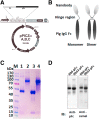Nanobody Nb6 fused with porcine IgG Fc as the delivering tag to inhibit porcine reproductive and respiratory syndrome virus replication in porcine alveolar macrophages
- PMID: 33596995
- PMCID: PMC7887809
- DOI: 10.1186/s13567-020-00868-9
Nanobody Nb6 fused with porcine IgG Fc as the delivering tag to inhibit porcine reproductive and respiratory syndrome virus replication in porcine alveolar macrophages
Abstract
Porcine reproductive and respiratory syndrome virus (PRRSV) is a highly contagious virus that has led to enormous economic loss worldwide because of ineffective prevention and treatment. In view of their minimized size, high target specificity and affinity, nanobodies have been extensively investigated as diagnostic tools and treatments of many diseases. Previously, a PRRSV Nsp9-specific nanobody (Nb6) was identified as a PRRSV replication inhibitor. When it was fused with cell-penetrating peptide (CPP) TAT, Nb6-TAT could enter the cells for PRRSV suppression. However, delivery of molecules by CPP lack cell specificity and have a short duration of action. PRRSV has a tropism for monocyte/macrophage lineage, which expresses high levels of Fcγ receptors. Herein, we designed a nanobody containing porcine IgG Fc (Fcγ) to inhibit PRRSV replication in PRRSV permissive cells. Fcγ fused Nb6 chimeric antibody (Nb6-pFc) was assembled into a dimer with interchain disulfide bonds and expressed in a Pichia pastoris system. The results show that Nb6-pFc exhibits a well-binding ability to recombinant Nsp9 or PRRSV-encoded Nsp9 and that FcγR-mediated endocytosis of Nb6-pFc into porcine alveolar macrophages (PAM) was in a dose-dependent manner. Nb6-pFc can inhibit PRRSV infection efficiently not only by binding with Nsp9 but also by upregulating proinflammatory cytokine production in PAM. Together, this study proposes the design of a porcine IgG Fc-fused nanobody that can enter PRRSV susceptible PAM via FcγR-mediated endocytosis and inhibit PRRSV replication. This research reveals that nanobody-Fcγ chimeric antibodies might be effective for the control and prevention of monocyte/macrophage lineage susceptible pathogeneses.
Keywords: PRRSV; antiviral agents; nanobody; nanobody-pFc; permissive cell targeting.
Conflict of interest statement
The authors declare that they have no competing interests.
Figures







Similar articles
-
A nanobody inhibiting porcine reproductive and respiratory syndrome virus replication via blocking self-interaction of viral nucleocapsid protein.J Virol. 2024 Jan 23;98(1):e0131923. doi: 10.1128/jvi.01319-23. Epub 2023 Dec 12. J Virol. 2024. PMID: 38084961 Free PMC article.
-
A Nanobody Targeting Viral Nonstructural Protein 9 Inhibits Porcine Reproductive and Respiratory Syndrome Virus Replication.J Virol. 2019 Feb 5;93(4):e01888-18. doi: 10.1128/JVI.01888-18. Print 2019 Feb 15. J Virol. 2019. PMID: 30463975 Free PMC article.
-
An intracellularly expressed Nsp9-specific nanobody in MARC-145 cells inhibits porcine reproductive and respiratory syndrome virus replication.Vet Microbiol. 2015 Dec 31;181(3-4):252-60. doi: 10.1016/j.vetmic.2015.10.021. Epub 2015 Oct 26. Vet Microbiol. 2015. PMID: 26525739
-
PRRSV receptors and their roles in virus infection.Arch Microbiol. 2015 May;197(4):503-12. doi: 10.1007/s00203-015-1088-1. Epub 2015 Feb 11. Arch Microbiol. 2015. PMID: 25666932 Review.
-
Non-structural protein 2 of the porcine reproductive and respiratory syndrome (PRRS) virus: a crucial protein in viral pathogenesis, immunity and diagnosis.Res Vet Sci. 2013 Aug;95(1):1-7. doi: 10.1016/j.rvsc.2013.03.015. Epub 2013 Apr 13. Res Vet Sci. 2013. PMID: 23591056 Review.
Cited by
-
A nanobody inhibiting porcine reproductive and respiratory syndrome virus replication via blocking self-interaction of viral nucleocapsid protein.J Virol. 2024 Jan 23;98(1):e0131923. doi: 10.1128/jvi.01319-23. Epub 2023 Dec 12. J Virol. 2024. PMID: 38084961 Free PMC article.
-
Boosting PRRSV-Specific Cellular Immunity: The Immunological Profiling of an Fc-Fused Multi-CTL Epitope Vaccine in Mice.Vet Sci. 2024 Jun 15;11(6):274. doi: 10.3390/vetsci11060274. Vet Sci. 2024. PMID: 38922021 Free PMC article.
-
Discovery of nanobodies: a comprehensive review of their applications and potential over the past five years.J Nanobiotechnology. 2024 Oct 26;22(1):661. doi: 10.1186/s12951-024-02900-y. J Nanobiotechnology. 2024. PMID: 39455963 Free PMC article. Review.
-
A Novel Blocking Enzyme-Linked Immunosorbent Assay Based on a Biotinylated Nanobody for the Rapid and Sensitive Clinical Detection of Classical Swine Fever Virus Antibodies.Microbiol Spectr. 2023 Feb 14;11(1):e0299622. doi: 10.1128/spectrum.02996-22. Epub 2023 Jan 23. Microbiol Spectr. 2023. PMID: 36688674 Free PMC article.
-
Tumor Susceptibility Gene 101 (TSG101) Contributes to Virion Formation of Porcine Reproductive and Respiratory Syndrome Virus via Interaction with the Nucleocapsid (N) Protein along with the Early Secretory Pathway.J Virol. 2022 Mar 23;96(6):e0000522. doi: 10.1128/jvi.00005-22. Epub 2022 Jan 26. J Virol. 2022. PMID: 35080428 Free PMC article.
References
MeSH terms
Substances
Grants and funding
LinkOut - more resources
Full Text Sources
Other Literature Sources
Miscellaneous

